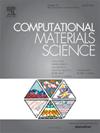A novel constrained sampling method for efficient exploration in materials and chemical mixture design
IF 3.1
3区 材料科学
Q2 MATERIALS SCIENCE, MULTIDISCIPLINARY
引用次数: 0
Abstract
Efficient exploration of multicomponent material composition spaces is often limited by time and financial constraints, particularly when mixture and synthesis constraints exist. Traditional methods like Latin hypercube sampling (LHS) struggle with constrained problems especially in high dimensions, while emerging approaches like Bayesian optimization (BO) face challenges in early-stage exploration. This article introduces ConstrAined Sequential laTin hypeRcube sampling methOd (CASTRO), an open-source tool designed to address these challenges. CASTRO is optimized for uniform sampling in constrained small- to moderate-dimensional spaces, with scalability to higher dimensions through future adaptations. CASTRO uses a divide-and-conquer strategy to decompose problems into parallel subproblems, improving efficiency and scalability. It effectively handles equality-mixture constraints, ensuring comprehensive design space coverage and leveraging LHS and LHS with multidimensional uniformity (LHSMDU). It also integrates prior experimental knowledge, making it well-suited for efficient exploration within limited budgets. Validation through two material design case studies, a four-dimensional problem with near-uniform distributions and a nine-dimensional problem with additional synthesis constraints, demonstrates CASTRO’s effectiveness in exploring constrained design spaces for materials science, pharmaceuticals and chemicals. The software and case studies are available on GitHub.

求助全文
约1分钟内获得全文
求助全文
来源期刊

Computational Materials Science
工程技术-材料科学:综合
CiteScore
6.50
自引率
6.10%
发文量
665
审稿时长
26 days
期刊介绍:
The goal of Computational Materials Science is to report on results that provide new or unique insights into, or significantly expand our understanding of, the properties of materials or phenomena associated with their design, synthesis, processing, characterization, and utilization. To be relevant to the journal, the results should be applied or applicable to specific material systems that are discussed within the submission.
 求助内容:
求助内容: 应助结果提醒方式:
应助结果提醒方式:


